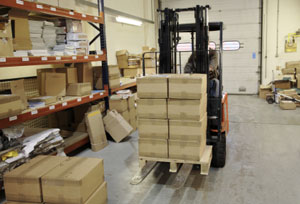Cube Optimization Streamlines Package, Pallet Size to Reduce Costs
With a slowing economy and rising transportation costs, today’s operations and fulfillment executives are constantly looking for the most efficient way to transport their deliveries from the manufacturing plant to the end customer. In the past, warehouse personnel would package product without any regard to efficiency or design. The result would be oversized packages not easily palletized that would add to the cost of transportation.

Now, not only are companies looking at the way the product is packaged, but also how that package is stacked on a pallet and how that pallet load is configured into a container.
There is a renewed emphasis on cube optimization, a system where a package is designed to efficiently sit in its primary container and where that container efficiently sits on a pallet based on the planned supply chain. The goal is to optimize the available space in containers and on pallets to help reduce costs.
Quint Marini, manager of UPS’s Package Design and Test Lab, says the company foresaw that this type of service was going to be necessary. UPS has designed product and pallet configurations for ocean and air containers for several companies that deliver to international markets. “We are taking a look at all aspects of the supply chain in trying to reduce carbon footprinting and transportation costs based on the design of a package,” he says.
In one particular case, cube optimization was able to help a company save on oversize charges on its packages, save on container costs because it was able to put more packages in a container, and save on the amount of floor space in their warehouse because it was able to stack its product more efficiently. The bottom line savings for the company was nearly $11 per package. This is not an isolated occurrence, and more and more fulfillment personnel are catching on to the potential cost savings associated with cube optimization.
Of course, if you optimize the cube, be sure to do it right. Don’t simply change the packaging size and materials to optimize the cube without regard to ensuring the product can be delivered without damages. In this era of cost savings, packages are becoming as tight and lightweight as possible, yet the challenge is to package the product properly to prevent damages to goods during the distribution and delivery phase. As one can imagine, if inappropriate materials or packaging techniques are used to improve transportation and distribution costs, then damaged goods costs will rise accordingly.
“What we’re trying to do is design and optimize a package using the least amount of packaging possible but the only way to validate that the package is sufficient is to conduct testing. Testing, along with design, creates the optimal packaging,” says Marini.
The obvious question then becomes, “Do fulfillment people have to become experts in packaging?” Not exactly. While it never hurts to understand the latest packaging techniques and materials, assistance is available. Vendors use a variety of computer programs and testing platforms to help operations and fulfillment personnel determine optimal packaging and pallet sizes and patterns.
Typical questions to get started include:
· Is it ocean or air freight?
· Are you sending complete or partial container loads?
· How many container loads are going out?
· How much product would fit into a given container?
· Size of the primary packs?
· Dimensions and weight of a single package?
· Are multiple products going out on a pallet – it could be a mixed load or more of a kit?
With the two most popular software programs, TOPS and CAPE, personnel can input the dimensions of the package in the primary pack and the software will optimize the pallet size and the way the boxes should be configured on a pallet. This can be done for ocean containers, as well as the different air containers.
Related Materials:
Keeping Small Beautiful
Bonsai tree supplier overcomes weather-related shipping obstacles with the help of UPS and handles the resulting increase in business.
Inside Storage and Inventory Control
Unless you have the product in stock — and your warehouse workers can get to it quickly and easily — you’re going to have a lot of unhappy customers.
Contact and Distribution Center Cost Cutting
If you’re like many of your colleagues, you’ve been asked to reduce operations costs or increase your department’s productivity and efficiency. Here are 15 areas to look at in the contact center and the distribution center.
Analyzing Packaging Costs
Choosing cost-efficient packaging is a complicated process that involves consideration of far more than just the cost of the materials alone.
